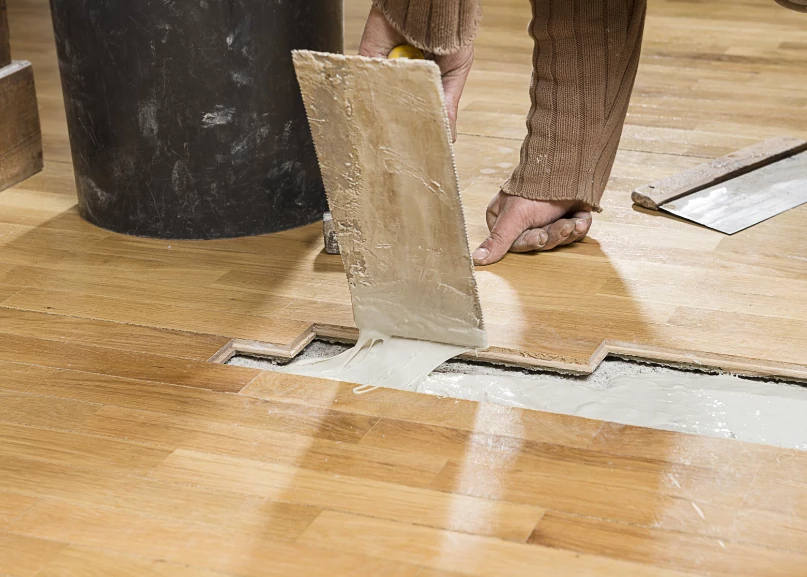Hardwood floors are a beautiful addition to any home, providing warmth and elegance that can last for decades. However, as with any investment, maintenance is key to keeping them looking their best.
When it comes to hardwood floor repair, even the smallest mistake can lead to costly consequences. From improper sanding techniques to using the wrong type of wood filler, there are several common pitfalls that DIYers and even professionals may encounter.
But fear not! With a bit of knowledge and careful attention to detail, you can avoid these mistakes and keep your hardwood floors in top condition for years to come.
In this article, we will explore some of the most common hardwood floor repair pitfalls and provide step-by-step instructions on how to properly fix them. Whether you’re dealing with scratches, dents, or water damage, we’ve got you covered with expert advice on how to restore your floors back to their former glory.
So grab your tools and let’s get started!
Common Hardwood Floor Repair Mistakes to Avoid
In the realm of hardwood floor repair, a multitude of common mistakes can arise, which, if left unaddressed or improperly fixed, can lead to significant and costly consequences.
One such mistake is failing to properly identify the source of moisture that caused damage to the flooring. This often results in ineffective repairs that ultimately lead to further damage down the line.
Another common mistake is using improper sanding techniques, which can not only leave visible marks on the surface but also cause irreparable damage to the wood itself.
To avoid these pitfalls and ensure long-lasting repairs, it’s crucial to rely on expert knowledge and experience in hardwood floor repair. Professionals are equipped with specialized tools and techniques that allow them to accurately diagnose issues and apply appropriate solutions. Additionally, they have access to high-quality materials that are specifically designed for use in hardwood flooring repair.
By avoiding common mistakes and relying on professional expertise, homeowners can save time and money while ensuring their floors look beautiful for years to come.
How to Properly Repair Hardwood Floors
Properly repairing hardwood floors entails identifying the specific problem that needs fixing, choosing the appropriate repair method, and utilizing effective sanding and refinishing techniques.
Identifying the problem is crucial to ensure that the right solution is applied, be it a simple patch or a complete floor replacement.
Choosing the right repair method involves considering factors such as floor condition, type of damage, and cost-effectiveness.
Sanding and refinishing techniques should also be executed with care to achieve an even finish and restore the beauty of your hardwood floor.
Identifying the Problem
By carefully examining the hardwood flooring, one can identify any issues and begin to determine the correct repair method.
The first step is to look for any signs of damage or wear on the surface of the floor. This may include scratches, dents, or chips in the wood.
It is important to note that not all damage requires a full replacement of the affected area; sometimes, a simple refinishing or spot repair may be sufficient.
Another key factor in identifying hardwood floor problems is understanding their cause. For example, if there are water stains on the floor, this could indicate a leaky roof or plumbing issue that needs to be addressed before repairs can be made.
Additionally, identifying any underlying structural issues such as uneven subfloors or warped boards can prevent further damage from occurring after repairs have been completed.
By taking a thorough and methodical approach to identifying hardwood floor problems, homeowners can ensure that they are making informed decisions about repairs and avoiding costly mistakes down the line.
Choosing the Right Repair Method
Selecting the appropriate method for repairing hardwood flooring involves carefully considering factors such as the extent of damage, type of wood, and desired outcome. A one-size-fits-all approach is not applicable when it comes to repairing hardwood floors because every situation requires a unique solution.
Below are some methods that can be used to fix common hardwood floor problems:
– Sanding: This method involves removing the top layer of the damaged wood using sandpaper. It is an effective way of dealing with scratches, dents, and shallow stains on hardwood floors.
– Filling: If there are gaps or holes in your hardwood floor, filling them with wood filler can help restore the uniformity of your floor’s surface. Be sure to choose a filler that matches the color and texture of your existing wood.
– Replacing: In some cases, replacing a damaged plank may be necessary. This typically involves removing the affected board and fitting in a new one.
– Refinishing: If you have deep stains or significant damage to your hardwood floor, refinishing may be required. This method entails sanding down the entire surface of your floor before applying a new stain or sealant.
By choosing the right repair method for your particular situation, you can avoid costly mistakes that could result in further damage to your hardwood floors. Always consider consulting with a professional if you’re unsure about which approach is best for your needs.
Sanding and Refinishing Techniques
Sanding and refinishing are two commonly used techniques for restoring the appearance of hardwood floors. Sanding is the process of removing the top layer of wood to expose a fresh surface, which can remove scratches, dents, and stains.
Before sanding, it’s important to inspect the floor for any loose boards or protruding nails that could damage the sander. A professional may use a drum sander or edge sander to ensure an even finish across the entire floor.
Refinishing involves applying a new stain or finish over the newly-sanded surface. This can be done with either water-based or oil-based finishes, depending on personal preference and durability needs. Water-based finishes are known for their low odor and fast drying time, while oil-based finishes may have a stronger odor but often offer greater protection against wear and tear.
Regardless of which option is chosen, it’s important to apply at least two coats of finish to achieve optimal results. With proper care and maintenance, sanding and refinishing can restore even heavily damaged hardwood floors back to their original beauty.
When to Call in the Professionals
Professional assistance may be necessary if the damage to your hardwood floors is extensive or if you lack the skills and experience required for proper repair.
While sanding and refinishing techniques can be learned, it takes years of practice to master them. Attempting to fix serious damages on your own could result in even costlier mistakes that may require professional intervention later on.
Furthermore, there are certain types of damage that require specialized tools and equipment that only professionals have access to.
For example, water damage can cause warping, buckling, and discoloration of the wood. Not only is this type of damage unsightly, but it can also compromise the structural integrity of your home.
Professionals have specialized moisture meters that allow them to detect hidden pockets of moisture in your flooring system. They also have powerful drying equipment that can dry out your floors quickly while minimizing secondary damage such as mold growth or bacterial contamination.
When it comes to repairing hardwood floors damaged by water or other extreme conditions, it’s always best to call in the experts rather than attempting a DIY fix that could make matters worse.
Frequently Asked Questions
What are some common mistakes people make when attempting to repair hardwood floors?
Repairing hardwood floors can be a slippery slope, where one wrong step can lead to disastrous consequences. Common mistakes include improper sanding, mismatched wood stains or finishes, and not addressing underlying issues such as humidity levels or subfloor damage.
Can I use any type of wood filler to repair scratches and gouges on my hardwood floors?
Not every wood filler is suitable for repairing scratches and gouges on hardwood floors. It is important to choose a filler that matches the species and color of the flooring and has good adhesion and durability.
How long does it typically take to properly repair hardwood floors?
The time needed for hardwood floor repair varies depending on the extent of the damage and the repair method. Minor scratches may take a few hours while larger repairs, such as replacing boards, may take several days to complete properly.
Are there any DIY methods for fixing water damage on hardwood floors?
DIY methods for fixing water damage on hardwood floors include using a dehumidifier to remove moisture, sanding and refinishing the affected area, and replacing damaged boards. However, it is recommended to seek professional help for extensive damage.
What should I expect in terms of cost if I need to hire a professional to repair my hardwood floors?
The cost of hiring a professional to repair hardwood floors varies based on the extent of damage, type and quality of materials needed, and labor costs. It is recommended to obtain multiple quotes from reputable contractors before making a decision.
Conclusion
In conclusion, hardwood floor repairs can be a daunting task, but by avoiding common mistakes and following proper techniques, it can be done efficiently. It is essential to identify the cause of damage before proceeding with repairs.
When fixing scratches or dents, sanding the area and applying stain or filler can help blend the repair into the surrounding floor. However, it is crucial to ensure that these repairs match the color and texture of the existing flooring.
It is also important to know when to seek professional help. Severe water damage or structural issues require expert attention for a safe and long-lasting solution.
Repairing hardwood floors often requires patience, skill, and precision, much like performing surgery on delicate tissue. By carefully assessing each situation and using appropriate methods, one can restore their hardwood floors to their former glory.
From Scratches To Squeaks: Troubleshooting Your Hardwood Floors
Are There Any Diy Methods For Performing Hardwood Floor Repairs, Or Is It Always Best To Hire A Professional?



